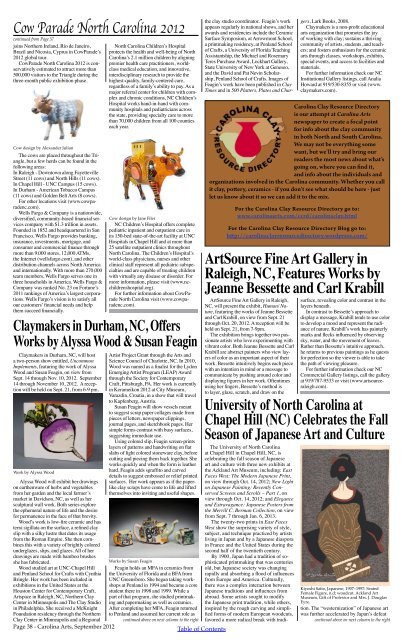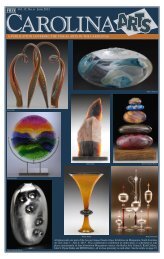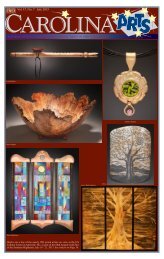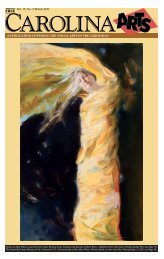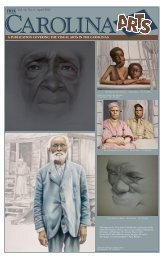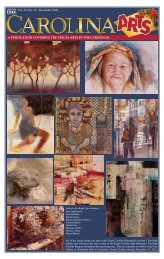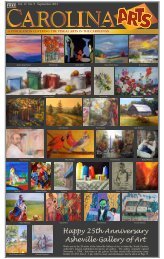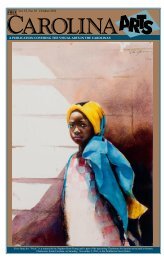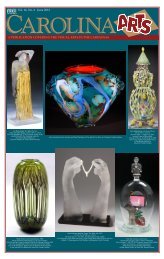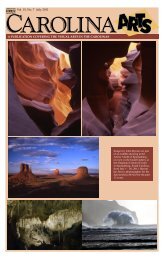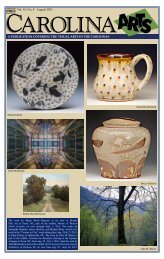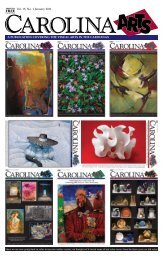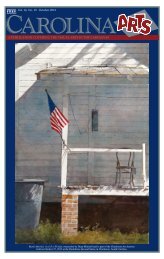Vol. 16, No. 9 September 2012 - Carolina Arts
Vol. 16, No. 9 September 2012 - Carolina Arts
Vol. 16, No. 9 September 2012 - Carolina Arts
Create successful ePaper yourself
Turn your PDF publications into a flip-book with our unique Google optimized e-Paper software.
Cow Parade <strong>No</strong>rth <strong>Carolina</strong> <strong>2012</strong><br />
continued from Page 37<br />
joins <strong>No</strong>rthern Ireland, Rio de Janeiro,<br />
Brazil and Nicosia, Cyprus in CowParade’s<br />
<strong>2012</strong> global tour.<br />
CowParade <strong>No</strong>rth <strong>Carolina</strong> <strong>2012</strong> is conservatively<br />
estimated to attract more than<br />
500,000 visitors to the Triangle during the<br />
three-month public exhibition phase.<br />
Cow design by Alexander Julian<br />
The cows are placed throughout the Triangle,<br />
but a few herds can be found in the<br />
following areas:<br />
In Raleigh - Downtown along Fayetteville<br />
Street (11 cows) and <strong>No</strong>rth Hills (11 cows).<br />
In Chapel Hill - UNC Campus (15 cows).<br />
In Durham - American Tobacco Campus<br />
(11 cows) and Golden Belt <strong>Arts</strong> (8 cows).<br />
For other locations visit (www.cowparadenc.com).<br />
Wells Fargo & Company is a nationwide,<br />
diversified, community-based financial services<br />
company with $1.3 trillion in assets.<br />
Founded in 1852 and headquartered in San<br />
Francisco, Wells Fargo provides banking,<br />
insurance, investments, mortgage, and<br />
consumer and commercial finance through<br />
more than 9,000 stores, 12,000 ATMs,<br />
the Internet (wellsfargo.com), and other<br />
distribution channels across <strong>No</strong>rth America<br />
and internationally. With more than 270,000<br />
team members, Wells Fargo serves one in<br />
three households in America. Wells Fargo &<br />
Company was ranked <strong>No</strong>. 23 on Fortune’s<br />
2011 rankings of America’s largest corporations.<br />
Wells Fargo’s vision is to satisfy all<br />
our customers’ financial needs and help<br />
them succeed financially.<br />
Claymakers in Durham, NC, will host<br />
a two-person show entitled, Uncommon<br />
Implements, featuring the work of Alyssa<br />
Wood and Susan Feagin, on view from<br />
Sept. 14 through <strong>No</strong>v. 10, <strong>2012</strong>. <strong>September</strong><br />
14 through <strong>No</strong>vember 10, <strong>2012</strong>. A reception<br />
will be held on Sept. 21, from 6-9 pm.<br />
<strong>No</strong>rth <strong>Carolina</strong> Children’s Hospital<br />
protects the health and well-being of <strong>No</strong>rth<br />
<strong>Carolina</strong>’s 2.1 million children by aligning<br />
premier health care practitioners, worldclass<br />
medical education, and innovative,<br />
interdisciplinary research to provide the<br />
highest-quality, family-centered care,<br />
regardless of a family’s ability to pay. As a<br />
major referral center for children with complex<br />
and chronic conditions, NC Children’s<br />
Hospital works hand-in-hand with community<br />
hospitals and pediatricians across<br />
the state, providing specialty care to more<br />
than 70,000 children from all 100 counties<br />
each year.<br />
Cow design by Jane Filer<br />
NC Children’s Hospital offers complete<br />
pediatric inpatient and outpatient care in<br />
its 150-bed state-of-the-art facility at UNC<br />
Hospitals in Chapel Hill and at more than<br />
25 satellite outpatient clinics throughout<br />
<strong>No</strong>rth <strong>Carolina</strong>. The Children’s Hospital’s<br />
world-class physicians, nurses and other<br />
clinical staff represent all pediatric subspecialties<br />
and are capable of treating children<br />
with virtually any disease or disorder. For<br />
more information, please visit (www.ncchildrenshospital.org).<br />
For further information about CowParade<br />
<strong>No</strong>rth <strong>Carolina</strong> visit (www.cowparadenc.com).<br />
Claymakers in Durham, NC, Offers<br />
Works by Alyssa Wood & Susan Feagin<br />
Work by Alyssa Wood<br />
Alyssa Wood will exhibit her drawings<br />
on earthenware of herbs and vegetables<br />
from her garden and the local farmer’s<br />
market in Davidson, NC, as well as her<br />
sculptural wall work. Both series explore<br />
the ephemeral nature of life and the desire<br />
for permanence in the face of that brevity.<br />
Wood’s work is low-fire ceramic and has<br />
terra sigillata on the surface, a refined clay<br />
slip with a silky lustre that dates its usage<br />
from the Roman Empire. She then combines<br />
this with a variety of brightly colored<br />
underglazes, slips, and glazes. All of her<br />
drawings are made with bamboo brushes<br />
she has fabricated.<br />
Wood studied art at UNC-Chapel Hill<br />
and Penland School for Crafts with Cynthia<br />
Bringle. Her work has been included in<br />
exhibitions in the United States at the<br />
Houston Center for Contemporary Craft,<br />
<strong>Arts</strong>pace in Raleigh, NC, <strong>No</strong>rthern Clay<br />
Center in Minneapolis and The Clay Studio<br />
in Philadelphia. She received a McKnight<br />
Foundation residency through the <strong>No</strong>rthern<br />
Clay Center in Minneapolis and a Regional<br />
Page 38 - <strong>Carolina</strong> <strong>Arts</strong>, <strong>September</strong> <strong>2012</strong><br />
Artist Project Grant through the <strong>Arts</strong> and<br />
Science Council of Charlotte, NC. In 2010,<br />
Wood was named as a finalist for the Lydon<br />
Emerging Artist Program (LEAP) Award<br />
through the Society for Contemporary<br />
Craft, Pittsburgh, PA. Her work is currently<br />
in Kerameikon <strong>2012</strong> at City Museum,<br />
Varazdin, Croatia, in a show that will travel<br />
to Kapfenberg, Austria.<br />
Susan Feagin will show vessels meant<br />
to suggest scrap paper collages made from<br />
pieces of letters, newspaper clippings,<br />
journal pages, and sketchbook pages. Her<br />
simple forms contrast with busy surfaces,<br />
suggesting immediate use.<br />
Using colored slip, Feagin screen-prints<br />
layers of patterns and handwriting on flat<br />
slabs of light colored stoneware clay, before<br />
cutting and piecing them back together. She<br />
works quickly and when the form is leather<br />
hard, Feagin adds sgraffito and carved<br />
details to suggest embossed or relief printed<br />
surfaces. Her work appears as if the paperlike<br />
clay scraps have come to life and lifted<br />
themselves into inviting and useful shapes.<br />
Works by Susan Feagin<br />
Feagin holds an MFA in ceramics from<br />
the University of Florida and a BFA from<br />
UNC Greensboro. She began taking workshops<br />
at Penland in 1994 and became a core<br />
student there in 1998 and 1999. While a<br />
part of that program, she studied printmaking<br />
and papermaking as well as ceramics.<br />
After completing her MFA, Feagin returned<br />
to Penland and assumed her current role as<br />
continued above on next column to the right<br />
Table of Contents<br />
the clay studio coordinator. Feagin’s work<br />
appears regularly in national shows, and her<br />
awards and residencies include the Ceramic<br />
Surface Symposium, at Arrowmont School,<br />
a printmaking residency, at Penland School<br />
of Crafts, a University of Florida Teaching<br />
Assistantship, the Michael and Rosemary<br />
Teres Purchase Award, Lockhart Gallery,<br />
State University of New York at Geneseo,<br />
and the David and Pat Nevin Scholarship,<br />
Penland School of Crafts. Images of<br />
Feagin’s work have been published in Clay<br />
Times and in 500 Platters, Plates and Char-<br />
The University of <strong>No</strong>rth <strong>Carolina</strong><br />
at Chapel Hill in Chapel Hill, NC, is<br />
celebrating the fall season of Japanese<br />
art and culture with three new exhibits at<br />
the Ackland Art Museum, including: East<br />
Faces West: The Modern Japanese Print,<br />
on view through Oct. 14, <strong>2012</strong>; New Light<br />
on Japanese Painting: Recently Conserved<br />
Screens and Scrolls – Part 1, on<br />
view through Oct. 14, <strong>2012</strong>; and Elegance<br />
and Extravagance: Japanese Posters from<br />
the Merrill C. Berman Collection, on view<br />
from Sept. 7 through Jan. 6, 2013.<br />
The twenty-two prints in East Faces<br />
West show the surprising variety of style,<br />
subject, and technique practiced by artists<br />
living in Japan and by a Japanese diaspora<br />
in France and the United States during the<br />
second half of the twentieth century.<br />
By 1900, Japan had a tradition of sophisticated<br />
printmaking that was centuries<br />
old, but Japanese society was changing<br />
rapidly and absorbing a flood of influences<br />
from Europe and America. Culturally,<br />
there was a complex interaction between<br />
Japanese traditions and influences from<br />
abroad. Some artists sought to modify<br />
the Japanese print tradition, while others,<br />
inspired by the rough carving and simplified<br />
forms of modern European woodcuts,<br />
favored a more radical break with tradi-<br />
gers, Lark Books, 2008.<br />
Claymakers is a non-profit educational<br />
arts organization that promotes the joy<br />
of working with clay; sustains a thriving<br />
community of artists, students, and teachers;<br />
and fosters enthusiasm for the ceramic<br />
arts through classes, workshops, exhibits,<br />
special events, and access to facilities and<br />
materials.<br />
For further information check our NC<br />
Institutional Gallery listings, call Analia<br />
Howard at 919/530-8355 or visit (www.<br />
claymakers.com).<br />
<strong>Carolina</strong> Clay Resource Directory<br />
is our attempt at <strong>Carolina</strong> <strong>Arts</strong><br />
newspaper to create a focal point<br />
for info about the clay community<br />
in both <strong>No</strong>rth and South <strong>Carolina</strong>.<br />
We may not be everything some<br />
want, but we’ll try and bring our<br />
readers the most news about what’s<br />
going on, where you can find it,<br />
and info about the individuals and<br />
organizations involved in the <strong>Carolina</strong> community. Whether you call<br />
it clay, pottery, ceramics - if you don’t see what should be here - just<br />
let us know about it so we can add it to the mix.<br />
For the <strong>Carolina</strong> Clay Resource Directory go to:<br />
www.carolinaarts.com/ccrd/carolinaclay.html<br />
For the <strong>Carolina</strong> Clay Resource Directory Blog go to:<br />
http://carolinaclayresourcedirectory.wordpress.com/<br />
ArtSource Fine Art Gallery in<br />
Raleigh, NC, Features Works by<br />
Jeanne Bessette and Carl Krabill<br />
ArtSource Fine Art Gallery in Raleigh,<br />
NC, will present the exhibit, Human/ Nature,<br />
featuring the works of Jeanne Bessette<br />
and Carl Krabill, on view from Sept. 21<br />
through Oct. 20, <strong>2012</strong>. A reception will be<br />
held on Sept. 21, from 7-9pm.<br />
The exhibition brings together two passionate<br />
artists who love experimenting with<br />
vibrant color. Both Jeanne Bessette and Carl<br />
Krabill are abstract painters who view layers<br />
of color as an important aspect of their<br />
work. Bessette intuitively begins each piece<br />
with an intention in mind or a message to<br />
communicate by pushing around color and<br />
displaying figures in her work. Oftentimes<br />
using her fingers, Bessette’s method is<br />
to layer, glaze, scratch, and draw on the<br />
surface, revealing color and contrast in the<br />
layers beneath.<br />
In contrast to Bessette’s approach to<br />
display a message, Krabill tends to use color<br />
to develop a mood and represent the radiance<br />
of nature. Krabill’s work has painterly<br />
marks and flecks influenced by observing<br />
sky, water, and the movement of leaves.<br />
Rather than Bessette’s intuitive approach,<br />
he returns to previous paintings as he quests<br />
for perfection so the viewer is able to take<br />
the path of viewing pleasure.<br />
For further information check our NC<br />
Commercial Gallery listings, call the gallery<br />
at 919/787-9533 or visit (www.artsourceraleigh.com).<br />
University of <strong>No</strong>rth <strong>Carolina</strong> at<br />
Chapel Hill (NC) Celebrates the Fall<br />
Season of Japanese Art and Culture<br />
Kiyoshi Saito, Japanese, 1907–1997: Seated<br />
Female Figure, n.d; woodcut. Ackland Art<br />
Museum, Gift of Professor and Mrs. J. Douglas<br />
Eyre.<br />
tion. The “westernization” of Japanese art<br />
was further accelerated by Japan’s defeat<br />
continued above on next column to the right


